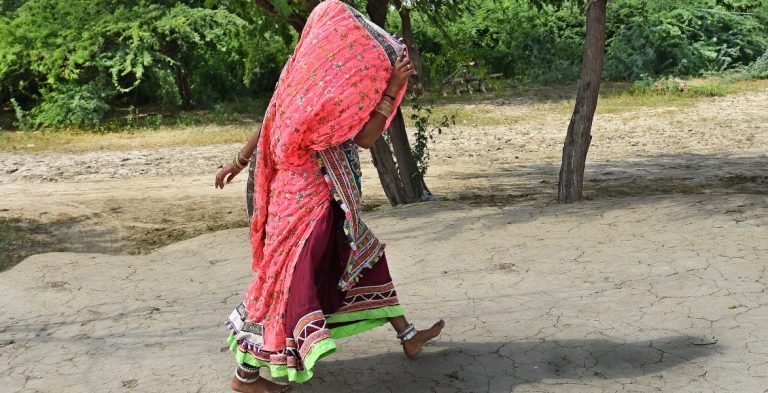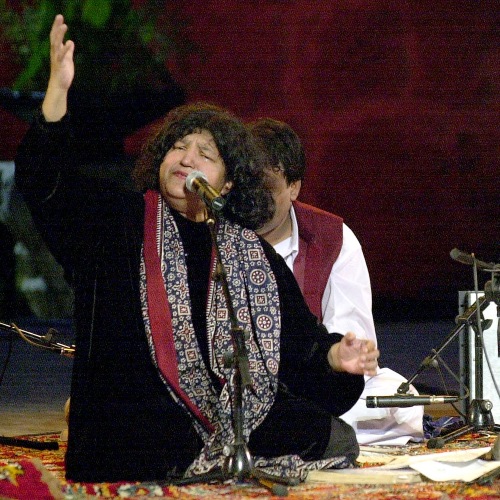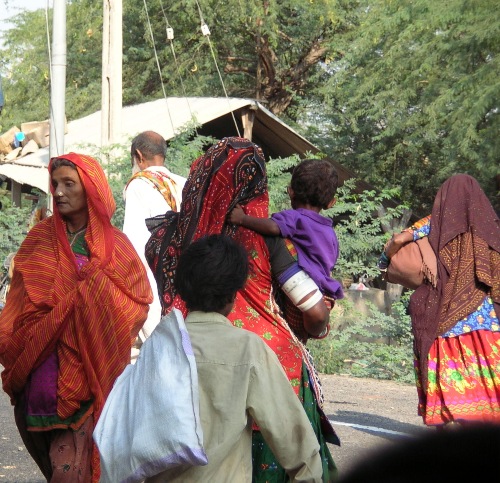
When I made my first visit to Pakistan I was welcomed with Sindhi Ajrak, bestowed upon me with other embroidered pieces, pickles from Shikarpur and I returned to India laden with love and materials.
The Ajrak is my entry into this world, and yet my parents never mentioned it to me.
By Rita Kothari
How the absence of material culture in my inherited Sindhi identity, was filled by gifts from Sindhis in Pakistan and Kutchi Muslims
Two decades back, when I first saw a picture of Pakistani singer Abida Parveen wearing an Ajrakh and singing songs of Sufi poet Shah Abdul Latif, I had not known that this was part of my heritage. I come from a mercantile family of Sindhi Hindus who, after Partition, took to livelihood as their first priority. Conversations regarding what people wore or remnants of that history in cultural artefacts were few and far between. In fact, objects were referred to by their prices, rather than design, material or motifs. My mother often asks, “Tuhinji hua panj sau vaari dress kithe aahe (Where is that dress of yours that cost 500 rupees?”). The coarseness of this approach irked my teenage self and it took me some years to understand where this might have come from.

Thus, these connections between objects and my Sindhiness were marked by many years through absence and even disavowal. Also, when I was growing up (during the Eighties), we tried hard not to be identified as a Sindhi in Gujarat. It generated a perception of being “Muslim-like” in the minds of mainstream Gujaratis. The shiny clothes Sindhis staying in the refugee camps of Wadaj and Kubernagar wore, were for me an unpleasant association. Coupled with this, there was an absence of heirlooms at home. In fact, my family was determined about its detached relationship with objects that can and should be left behind when migration or death occurs.
I remember how empty my father’s cupboard became the moment he died. I stared at the empty spaces and mourned not having materials of memory. An ominous sense of transience characterized my life in those years and it took some time to situate that in both the present and past of my parents’ lives.
In fact, when I read Aanchal Malhotra’s book Remnants of Separation published last year I was reminded of how my journey has not been one of inheriting objects, but rather of creating one. The account below throws light on this phenomenon.
Then came a time when I made my first visit to Pakistan. I was welcomed with Sindhi Ajrakh, bestowed upon me with other embroidered pieces, pickles from Shikarpur and I returned to India laden with love and materials. Since then, my Sindhiness extended from being a place of lack and inadequacy to one of excess and celebration. In the intermittent years when I started to spend time in Banni, in Kutch this relationship became even stronger. The women of Banni made me wear their kanjris (embroidered tunics) and had a photograph of mine taken. Through these objects, I left feeling that my sense of Sindhiness now encompassed regions and religions and I could revel in being a subcontinental Sindhi, rather than the “adh-mussulman” (half Muslim) Sindhi of Gujarat.
While I was writing this piece in September, I attended the World Sindhi Congress (WSC) in London. This 31st session, like many others preceding it, laid out the marginalization and atrocities against Sindhis in Pakistan. As an Indian Sindhi, I felt protected and sheltered from the accounts I was listening to. Rather my generation is protected and sheltered. Our parents who crossed the border certainly faced worse adversities. As I sat there on the dais with the Sindhi Ajrakh around my neck, I felt one with Sindhi nationalists Dada Rochiram, Dada Khalique Junejo who had spent a lifetime working in Sindh. The Ajrakh is my entry into this world, and yet my parents never mentioned it to me. It’s quite possible that the Ajrakh rose from being a local symbol to a national badge in Sindh during the heydays of Sindhi nationalism. It’s also quite possible that around the same time Jhulelal, the river god worshipped by Sindhi Hindus rose from being a local symbol to a Brahma-like deity.
Be that as it may, our Sindhi worlds are both connected and divided. One of the attendees at the London Congress gave me a kurta with Sindhi embroidery. I looked at it longingly, knowing that this material connection with Sindh was now going to be mediated through people I met abroad. I would now be picking up my Ajrakh or kanjri from people who travel to me, instead of travelling myself to those places.

But the next moment, images of Niayamat and Sabia in Banni, both embroidery artisans float before my mind. In my mind’s eye I see them wearing mutwa and jat embroidery (community specific hand embroideries of Kutch), proudly displayed on their kanjris. I ask myself why did I think of Sindh ‘over there’ again? There are parts of Sindh next to me in Gujarat.
Today I flaunt my kanjri given to me by women of Banni, and the Ajrakh given to me by Sindhi nationalists. It is through these objects that I have filled the gap of my childhood. The remnants were missing, but they are now aplenty, just like the love that became available to me on both sides of the border.
___________________
[author title=”Rita Kothari ” image=”https://sindhcourier.com/wp-content/uploads/2021/05/Rita_Kothari_Writer-e1619891161388.jpg”]Rita Kothari is a Sindhi author and academician who grew up in Gujarat. Her book ‘The Burden of Refuge: Sindhi Hindus in Gujarat’ pioneered the study of Partition in the context of Sindhis. ‘Unbordered Memories’ was an English translation of Sindhi stories while ‘Memories and Movements: Borders and Communities in Banni’, Kutch examines Banni and the Sindh imaginary among pastoralist communities.[/author]
Courtesy: The Voice of Fashion (Published on November 5, 2019)